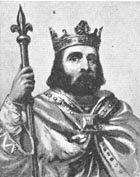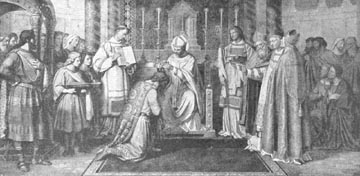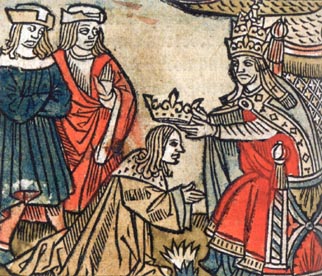Pépin the Short
 Following the death of their father Charles Martel in 741, Pépin
the Short along with his older brother Carloman imprisoned their half brother
Grifo and took control of the Frankish Empire as joint Mayors of the Palace.
Pépin ruled in Neustria, Burgundy and Provence and Carloman ruled
in Austrasia. In order to legitimize their rule, the brothers revived
the kingship by raising Childeric III to the throne in 743. Pépin
and Carloman continued to hold the real power. That same year, Pépin
and Carloman conquered their brother-in-law Duke Odilo of Bavaria.
However, discord in Bavaria continued; and it was not until 757 that Odilo's
son (Pépin's nephew) Duke Tassilo III of Bavaria
and the magnates of Bavaria were finally forced to acknowledge themselves
as vassals of Pépin the Short.
Following the death of their father Charles Martel in 741, Pépin
the Short along with his older brother Carloman imprisoned their half brother
Grifo and took control of the Frankish Empire as joint Mayors of the Palace.
Pépin ruled in Neustria, Burgundy and Provence and Carloman ruled
in Austrasia. In order to legitimize their rule, the brothers revived
the kingship by raising Childeric III to the throne in 743. Pépin
and Carloman continued to hold the real power. That same year, Pépin
and Carloman conquered their brother-in-law Duke Odilo of Bavaria.
However, discord in Bavaria continued; and it was not until 757 that Odilo's
son (Pépin's nephew) Duke Tassilo III of Bavaria
and the magnates of Bavaria were finally forced to acknowledge themselves
as vassals of Pépin the Short.
In 747, Carloman withdrew from politics.
With the support of the church and the Pope, Pépin had himself declared
King of the Franks in 751. The former king, Childeric III, retired to a
monastery.

|
The Coronation in 751 of
Pépin the Short
conducted by St. Boniface,
who was acting the representative
of the pope.
|
 |
A French fresco showing
the Coronation in 751 of
Pépin the Short
conducted by St. Boniface.
|
In the winter of 753-754 after the
Lombards forced Pope Stephen to leave Rome, the Pope visited Pépin
the Short. The next summer, Pope Stephen anointed Pépin and
his two sons Charlemagne and Carloman, and declared that the Franks were
never to elect a king who was not of the sacred lineage of Pépin
the Short. In return for Pope Stephen's support, Pépin the
Short took his army to Italy and defeated the Lombards. Pépin's
gift of a wide strip of land in central Italy to the Pope became known
as the "Donation of Pépin". This land, called the Papal States,
remained under the control of the popes until the unification of Italy
in the 19th century.
Click to return to the Charlemagne
Page or use your browser's back button.
Please visit the Sewell
Genealogy Site Map for other pages in this series.
This summary was written in July 2006 by Robert
Sewell using sources including the following:
World Book Millenium 2000 Deluxe Edition,
© 1999 World Book Inc., © IBM Corp.
Microsoft Encarta Encyclopædia 99,
© 1993-1998 Microsoft Corporation
Norman F. Cantor (ed.) The Encyclopædia of
the Middle Ages, New York, 1999
Berhard Grun, The Timetables of History,
New York, 1991
The Book of History (18 Volumes), London,
1914
The Kings of France, http://www.beyond.fr/history/kings.html
Brian Tompsett, Royal Genealogical Data,
http://www3.dcs.hull.ac.uk/genealogy/royal/
 Following the death of their father Charles Martel in 741, Pépin
the Short along with his older brother Carloman imprisoned their half brother
Grifo and took control of the Frankish Empire as joint Mayors of the Palace.
Pépin ruled in Neustria, Burgundy and Provence and Carloman ruled
in Austrasia. In order to legitimize their rule, the brothers revived
the kingship by raising Childeric III to the throne in 743. Pépin
and Carloman continued to hold the real power. That same year, Pépin
and Carloman conquered their brother-in-law Duke Odilo of Bavaria.
However, discord in Bavaria continued; and it was not until 757 that Odilo's
son (Pépin's nephew) Duke Tassilo III of Bavaria
and the magnates of Bavaria were finally forced to acknowledge themselves
as vassals of Pépin the Short.
Following the death of their father Charles Martel in 741, Pépin
the Short along with his older brother Carloman imprisoned their half brother
Grifo and took control of the Frankish Empire as joint Mayors of the Palace.
Pépin ruled in Neustria, Burgundy and Provence and Carloman ruled
in Austrasia. In order to legitimize their rule, the brothers revived
the kingship by raising Childeric III to the throne in 743. Pépin
and Carloman continued to hold the real power. That same year, Pépin
and Carloman conquered their brother-in-law Duke Odilo of Bavaria.
However, discord in Bavaria continued; and it was not until 757 that Odilo's
son (Pépin's nephew) Duke Tassilo III of Bavaria
and the magnates of Bavaria were finally forced to acknowledge themselves
as vassals of Pépin the Short.

